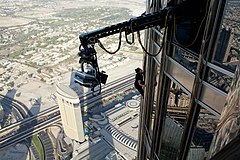Technocrane

Technocrane is a telescopic camera crane widely utilised in the film industry and in television production. The first Technocrane, invented by Horst Burbulla, revolutionized the world of camera movement for film and television production when it was first introduced to the world in 1983. The first five Technocranes were built in Bonn, Germany, and London, UK, with support from Technovision Ltd.
The camera is mounted on the remote head on the end of the crane and basend on model is remote controlled by a camera operator at a control desk or standing at rear of the crane in single op mode. The Technocrane can telescope at variable speeds on demand. It allows camera moves that cannot be achieved using a jib arm crane and camera dolly,[1] and the telescoping can be used to compensate for the camera moving in an arc called "arc compensation".[2]
History
[edit]Technocrane S.R.O. was founded in 1991, and the original Technocrane has been manufactured in Plzen, Czech Republic since that time. Currently situated in an immaculate and modern 10,000 square meter production facility, 65 employees assemble approximately 40 telescopic camera cranes every year.

Mounted on a mobile crane base known as the "TechnoBase," the cranes can be quickly relocated between filming locations. The most innovative and recognizable aspect of the Technocrane design is its sliding counterweight system. The crane’s remote-controlled camera head (either the current Technohead S or Technohead LT) is mounted at the front of the telescopic arm, and as the arm extends, the counterweight shifts rearward to maintain perfect balance. This precise design allows for smooth camera movements even while the arm is extending and retracting.
The original Technocrane could lift a camera to a height of 6 meters (18 feet). As technology progressed, so did the crane’s capabilities. In 1993, the SuperTechno30, with a maximum lens height of 9.2 meters, was introduced. This was followed by the SuperTechno50 in 2002, which could extend to 15 meters/48.6 feet.

In recognition of his contributions to the film industry and for: The Invention and Continuing Development of the Technocrane telescopic camera crane, The Academy awarded Horst an Oscar and, The Academy Award of Merit. Horst thanked his clients, family and mentioned the "Golden Hands" of the Technocrane employees without which the elegant movement provided by the Technocrane would not be possible.
In 2006, Technocrane took another significant step forward with the introduction of the Technodolly— the first fully automated telescopic camera crane. With its completely proprietary software system, the Technodolly allowed for the creation of complex, long tracking shots with keyframe programming, enabling precise repetition of these shots with incredible accuracy and minimal audio signature.

The Technodolly (25,15,10) model line has quickly become a favorite tool for directors in both scripted film and commercial productions, and it has since become a key asset for live broadcast directors worldwide.
As of it's release to the public in November of 2024, and with its compact size, the Technodolly 10 has become a must have for broadcast facilities upgrading to LED volumes and virtual tracking systems as camera tracking features are now integrated into all of Technocranes three model lines and integrate seamlessly with those new technologies.
Usage
[edit]Productions that have used the Technocrane or the later SuperTechnocrane include Titanic, the Harry Potter films, the Lord of the Rings films, Game of Thrones, Avengers, Mandalorian and all the James Bond films of the late 1990s and 2000s, among many others.
Gallery
[edit]-
Technocrane used during the filming of X-Men: First Class (2011)
-
Technocrane with remote camera head
-
SuperTechno 30
-
Technocrane used during the filming of Ghost Protocol
-
The incrdedibly versatile TechnoDolly10/12 installed with PGA Tour Studios.
See also
[edit]References
[edit]- ^ Cury, Ivan (2005). TV commercials: how to make them, or, how big is the boat?. Elsevier. pp. 235. ISBN 0-240-80592-5.
- ^ Brown, Blaine (2002). Cinematography: Theory and Practice: Imagemaking for Cinematographers. Focal Press. p. 303. ISBN 0-240-80500-3.





